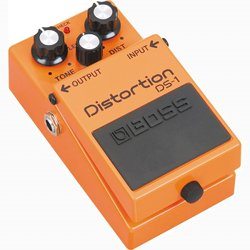 Missed part one? Catch up here.
Missed part one? Catch up here.Last time around we talked about the basics of amplifier distortion: What it is, where it came from and what it sounds like. Now it’s time to discuss the non-amp distortion gizmos out there that claim to be able to replicate the dirty sound of amplifier crunch. Bold claim! Can they do it? Let’s find out.
First, we need to define a few terms so that you aren’t flying blind! We have already established the 3 primary distortion-creating sections of an amp:
- The pre-amp, consisting of the pre-amp tubes
- The power amp consisting of the power tubes
- Power tube compression and drive.
The basic functions of these 3 sections are as follows:
Pre-amp
This is where the input signal is shaped, EQ’d (most of the time – but there are exceptions!), and distorted to various degrees. Since this is the first stage only, pre-amp-only distortion is described as being raspy, over-compressed (due to the particular characteristics of the pre-amp tubes), and thin sounding in general.
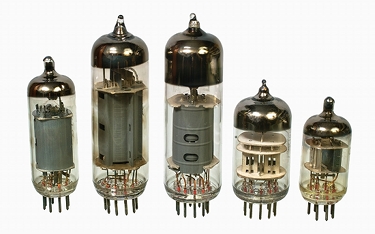
Power amp
After the pre-amp shaping stage, this is where the actual “amp” part works. The power tubes can be driven as softly or as hard (louder) as possible. Usually, the louder you drive the power tubes, the fatter and plumper the sound. This is often the desired timbre that musicians desire. However, since not an enormous amount of distortion is produced at the power section, this is where the contribution from the pre-amp or other “boost” device (to be discussed later) adds, and compliments to the power amp sound. If the amp is set up correctly, distortion Valhalla is the result!
Power tube compression and drive
Here is where the power tubes exhibit their particular characteristics and provide compression! This is such an important part of the overall tone, because no matter how much or how little distortion one chooses to use, the compression effect of the overdriven power amp supplies near endless sustain; which if you recall, was one of the main attractions and benefits of distortion in the first place!
This is THE most difficult part to replicate synthetically.
Now, on to the effects. First a sneak peek at the sounds of these effects:
Can you hear the differences? Don’t worry, we’re going to break it down for you below!
Non-amp distortion effects
There are too many branches and subdivisions of these types of devices to even consider documenting, but as usual we will look at the basic archetypes from which all the rest stem. Up until now, we’ve used the term “distortion” very loosely, but now we’ll be specific in the terminology used. There are 3 basic categories of effects we’ll look at:
- Boosters and Overdrives
- Distortion (from classic rock all the way to “scooped” metal pedals)
- Fuzz
Most of these units are plugged into the front end of an amplifier, which in conjunction with the amp’s tone controls and speakers can provide a variety of textures.
Although these are usually plugged in between a guitar and amplifier, there are no “rules” dictating how and where these effects may be used – thus making them widely accessible to EVERYONE, not just guitar players! (More on that in Part 3!)
Boosters and Overdrives
Boosters
These units produce the mildest form of “distortion” of the whole bunch. Boosters are actually clean and “linear” sounding. All they do is make the incoming signal louder, so that it can drive an amp harder in order to produce more of the amp’s natural distortion. Very handy when you have and older, or “vintage” amp that has a relatively clean pre-amp stage, and just needs some extra “push” to get the power section cooking.
Applications for non-guitar sources can range from making a weaker signal “hot” enough for recording, all the way to driving it loudly enough to dirty that sound up a little. Bass players, keyboards – actually anything can be a candidate for boost!
Electronically, boosters do not “clip” or distort the signal: they just amplify it. This is what’s meant by “linear” boosting.
Overdrives
Overdrives pick up where boosters leave off. They do produce a bit of distortion, although it is very mild to medium at most. An overdrive is designed specifically to work in conjunction with an already-distorted amp, or signal source.
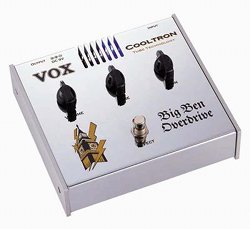 Their best use is pushing an amp that has the power amp thing going, but isn’t fully distorted. At this point the overdrive acts as a booster, and contributes its own bit of break up. The end result is that fully saturated smooth lead sound we all know, and dare I say… love!
Their best use is pushing an amp that has the power amp thing going, but isn’t fully distorted. At this point the overdrive acts as a booster, and contributes its own bit of break up. The end result is that fully saturated smooth lead sound we all know, and dare I say… love!
An overdrive is actually designed to mimic the slight breakup or “overdriven” sound of a fully cranked old tube amp. Those amps if you recall, did not produce a lot of distortion; just a powerful “hit you over the head” sound. There is not enough distortion to make each note flow into each other as with heavy “lead” distortion, just enough to wake you up. As a consequence, a lot of overdrives can sound a little weak for lead work by themselves. Then again, consider the fact that they were designed to work with an already distorted source. In that environment, you can dial in as much distortion as you need. One nice benefit from this method is that the workload is split up into smaller gain steps. What I mean is that you don’t have your distortion produced from just one source that is doing all the work. In this scenario, you are splitting it up, allowing for individual EQ and fine tuning of each component. The result: a nice rich sound.
One good benefit from using just an overdrive’s sound is the inherent clarity present in its lower amount of distortion. This is a result of overdrives usually amplifying the even harmonics of a signal (remember all about harmonics?). Everything else is pretty much left alone – smooth and clear is the order here.
Now there is a small variation that you need to be aware of: “clipping”.
Clipping
Electronically, overdrives, distortions and fuzzes distort the wave of the signal. Remember the basic sine wave shape? These effects usually chop off the tops and bottoms of the peaks of the wave – this is why it’s called “clipping”. This distorts the sound of the signal.
We won’t go into the signal processing details. If you want to know more, here’s a good clipping tutorial. We’ll stick to the fundamentals for now so we can get to the good stuff: Listening!
Clipping can be “soft” (gentler, less distorted) or “hard” (harsher, more distorted).
There are also 2 styles of clipping, each of which can be soft- or hard-clipped.
Symmetrical clipping clips equal amounts of signal form the positive and the negative peaks of the signal wave. This means that only the 2nd, 4th, 6th, etc. (all the even harmonics) are amplified, creating “harmonic” overdrive, or distortion.
The result is that the sound is in consonant harmony with the input signal. This make it ideal for complicated chordal playing, as everything sounds in tune. This sound was based on replicating a tube amp with electronically-matched tubes. In simple terms, the amp has been calibrated to run all the tubes in balance. This is not unlike setting the timing on an automobile. (For those who remember timing belts and points!)
Asymmetrical clipping devices clip one side of the signal more than the other side. This amplifies and brings the “odd” numbered harmonics more to the forefront, which generally creates a more dissonant sound. The result is that the sound produced has a subtle but constant noticeable tension to it. Notes seem to want to clash with each other, as opposed to working in harmony.
This particular form of clipping was designed to replicate an amplifier with mis-matched tubes. Once again, similar to car whose timing is a smidge off, and whose cylinders aren’t totally in lockstep. The amp’s tubes run and burn in a slightly unbalanced manner; and while not “textbook” correct, produces that tension which many musicians love.
Distortions
Distortions are meant to be standalone tone producers. They are designed to replicate the pre-amp and power amp distortions along with the appropriate compression.
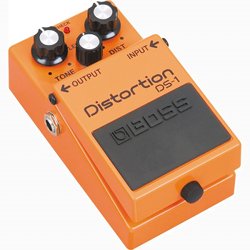 They are not meant to be run into an already distorting signal or amp. They are meant to produce the whole of what a more modern amplifier can provide. Distortion units can be symmetrically or asymmetrically clipped. The difference again, is subtle but noticeable.
They are not meant to be run into an already distorting signal or amp. They are meant to produce the whole of what a more modern amplifier can provide. Distortion units can be symmetrically or asymmetrically clipped. The difference again, is subtle but noticeable.
A common question might be: with all amp manufacturers tripping over each other to produce modern “high gain” amplifiers, why the need for external distortion?
Simple answer:
Variety.
You can never have enough colors to paint with!
A more practical answer is the fact that you simply might not be happy with your amplifier’s inherent distortion sound. Therefore by employing the services of outboard devices fed into your amplifier’s clean setting, you maximize versatility, as well as meeting your particular tonal needs.
Also, remember what we said above – distortion devices can actually be very useful for dirtying up all kinds of sources, not just guitars! So having the distortion tone separated from the amplifier allows for a lot more possibilities…
Fuzz
We are now at the last if the big three. Fuzz. A more accurate descriptive term could not have been found!
Fuzz units produce a very wooly, out of control, pliable, ultra-distorted tone. In fact, one of the main characteristics of a “fuzz” is the soft and inarticulate roundness to the sound in the lower frequencies – Especially the low E string of a guitar, which sounds at what Hz? (Sorry – a little impromptu quiz!)
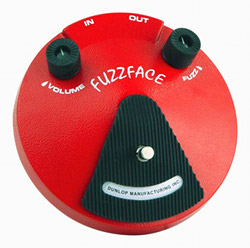
That roundness gives the high strings of a guitar a very “squishy” fatness. Great for taming a shrill sounding guitar. Once again though, this sound is not a tight or articulate sound. The quintessential audio example for a fuzz sound is classic Hendrix recordings. Jimi used to run his fuzz boxes into an already distorting amp to get his sonic brew happening.
Did you catch that last line? An already distorted amp!
But doesn’t this contradict what we talked about earlier? Well, no. Not exactly.
One of the most peculiar characteristics of fuzz units is the fact that they really blend well with a distorted amplifier. Their electronic makeup sees to that. While most distortion boxes fed into a distorted sound produces a putrid mess, fuzz units take to a distorted sound like a fish to water. Fuzz sounds certainly aren’t the most polite or the most controllable, but when that sound is required… nothing else will do!
The clipping that fuzz units use is rather unique. The main characteristic feature is that is responds very dynamically to the input signal. With that in mind, fuzz effects usually start out with a soft, mellow clipping, with asymmetrical properties. Then, based on the input signal, develops into a harder clipped sound with symmetrical properties. It’s this ever-changing phenomenon that makes this effect so appealing to countless musicians!
Homework
This is a continuation of the exercises from Distortion Effects, Part 1. Hopefully by now you have a basic understanding of the key “must know” distortion sounds. If not, make sure you do, before continuing.
The following samples are all overdrive/distortion/fuzz effects generated by standalone units, and in a few instances software effects.
These samples here are all from the 3 core genres: Overdrive, Distortion, and Fuzz.
To do:
- Listen, and listen again. Internalize the sounds of each type of effect.
- Break out those software spectrum analyzers and analyse the frequencies present, like in Part 1. Now compare the data you collect to the previous data you collected from the part 1 “amp” samples. What do you think? I’ll have a comment about that later – for now just make personal notes.
- This is great place to do a little side-by-side comparison as well. Jot down notes on the characteristics of each “type”. Also notice what happens to the frequency response of these sounds compared to each other. Which are brighter? More distorted? “Muddier”? “Splattier”? Those aren’t necessarily bad characteristics – but you do need to be able to tell the difference between a basic overdrive sound and a hard fuzz for instance.
- This should go without saying, but once again: fire up those DAWs, open up the plug-ins folder or use stand alone units (whichever you have or prefer) and start plugging EVERYTHING in there! From acoustic guitars all the way to a kazoo! Do I need to say more?
- Make sure you memorize the sound of the 2 samples demonstrating symmetrical vs. asymmetrical. The difference is subtle but crucial. Notice that the asymmetrical clipping has a certain underlying dissonant quality to it, whereas the symmetrical clipping doesn’t.
THIS is the most important tool in selecting what type of overdrive/distortion/fuzz you want to choose for your source material. The symmetry or asymmetry is what will tell you above all how it will behave with your sound source!
Now, on to the sounds!
Compare: Overdrive, Distortion and Fuzz
Same lick played total of 4 times:
- 1st is clean original
- 2nd is with Overdrive
- 3rd with Distortion
- 4th with Fuzz
- Played into a Fender Deluxe set clean
- Symmetrical overdrive: pedal effect
- Symmetrical distortion: pedal effect
- Fuzz: pedal effect
- Played clean through a bass amp simulator fed into DAW
- Asymmetrical overdrive: pedal effect
- Asymmetrical distortion: pedal effect
- Hard fuzz: software plugin
- Roland sound module direct into DAW
- Asymmetrical overdrive: tube pre-amp overdrive pedal
- Symmetrical distortion: built in to the organ sound module
- Hard fuzz: pedal effect
Adding Extra Overdrive
- Guitar lick played into my mildly driven Marshall
- Guitar prepped through overdrive, then fed into the Marshall
Same settings, pedal effect. Almost forgot: asymmetrical overdrive.
Hint: Asymmetrical overdrives feeding slightly distorted amps blend VERY well together!
Symmetrical vs. Asymmetrical Clipping
- Guitar lick through exaggerated symmetrical clipping circuit. Software plug in.
- Guitar lick through exaggerated asymmetrical clipping circuit. Software plug in.
Note the underlining dissonance. Subtle, but it’s there!
Bonus Question
Our question from last time was:
There are three primary sections (broad categories of course) that contribute to an amp’s tone… especially the distortion tone. First is the pre-amp, second is the power amp.
What is the third?
The answer: “power tube compression.”
Hmmm, it has the word compression in it – look familiar?
Think back to the dynamics effects article and consider how a compressor works.
Now apply it to a fully cranked amp. First, the pre-amp section takes the input signal and preps it for delivery to the power amp. Now the signal is strong enough to enter the power section of the amp. At his stage, the power tubes amplify the signal to the point of being able to drive a speaker. Now here is the compressor part: the harder the amp/power tubes are driven, the more the output signal is naturally compressed, reducing the dynamic range of the amp, increasing the overall output volume level, and most importantly: increasing the sustain of the sound! This natural sustain produced by power tube compression is very difficult to reproduce with a non-amp distortion effect (but not impossible!)
Arguably, some of the best distortion sounds are derived from the perfect blend of pre-amp distortion and power amp/power tube distortion. The pre-amp gives just enough preparation to the sound, and then the power section does the rest. Certainly everything we discussed in Distortion Effects, Part 1 was from that school of thought!
And now this week’s question:
Where was the first echo (or delay) effect first manufactured?
Now you have the bulk of distortion effects under your bulk.
But there’s still more…
Come back next time for more about the endless variations of distortion, and using these effects on less obvious instruments! Until then…

